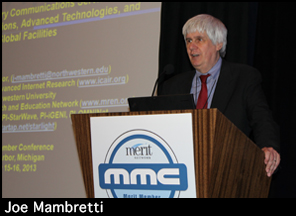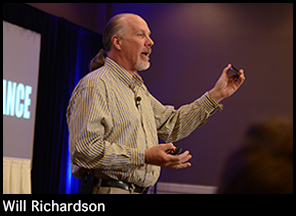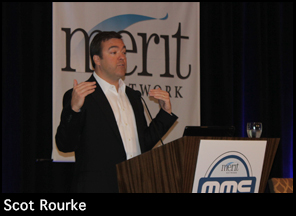ANN ARBOR – The Merit Member Conference brought IT executives, networking professionals, and others to Ann Arbor for two days of presentations and discussions focused on networking, collaboration, mobile technologies, security, and other relevant topics. The fifteenth annual event returned to the Sheraton Ann Arbor and hosted over 300 attendees from Michigan and beyond.
Featured Speakers
“Creating 21st Century Communication Services: Next Generation Applications, Advanced Technologies, and Global Facilities”
Joe Mambretti, International Center for Advanced Internet Research (ICAIR), Northwestern University, director, Metropolitan Research and Education Network (MREN)

Joe Mambretti is director of the International Center for Advanced Internet Research (ICAIR) at Northwestern University, which is focused on developing digital communications for the 21st Century. ICAIR, created in partnership with a number of major high tech corporations, designs and implements large-scale infrastructure and applications at the metro, regional, national and global levels.
Joe is also director of the Metropolitan Research and Education Network (MREN), an advanced high-performance network interlinking and providing services to institutions in seven upper-Midwest states. MREN designed and developed the world’s first GigaPOP.
The focus of ICAIR is to create and implement new services and technologies on advanced networks. Important research topics that support this initiative include:
A scaling Internet, which will grow from 1-2 billion users currently to 4-6 billion users
Migrating Layer 3 services to Layer 1, Layer 2 and even Layer 1.5, something Mambretti calls a “hybrid Internet”
Migrating from an Internet replete with low-definition data, images, video to one characterized by true high-definition, full-color, depth of field, interactive media
Empowering Edge networks to take full advantage of evolving IT services and network virtualization
Mambretti also discussed an emergent trend toward private networks. The financial and government sectors, medical and research and education communities all currently leverage private networking. Increasingly, Mambretti predicts, individuals will create their own national and even international networks—a shift from a shared to a personal network that mirrors the rise of the PC (personal computer).
“Learning in a Networked World: For Ourselves and for Our Students”
Will Richardson, willrichardson.com

A parent of two school-aged children, Will Richardson has been thinking and writing about the intersection of social online learning networks and education for the past 10 years at Weblogg-ed.com and in numerous journals and magazines such as Ed Leadership, Education Week and English Journal, and most recently at willrichardson.com. He is an outspoken advocate for change in schools and classrooms in the context of the diverse new learning opportunities that the Web and other technologies now offer. He is a former public school educator for 22 years, and is a co-founder of Powerful Learning Practices, a unique professional development program that has mentored over 5,000 teachers worldwide in the last five years.
Richardson believes that advances in technology and the proliferation of high-speed Internet dictate a shift in what may be commonly referred to as “traditional” learning and education. And in his eyes, we are living in what is most likely the most disruptive time in the history of education.
Anyone, and more importantly school-aged learners, can now learn deeply on their own and teach others on their own. We are living in an age of abundance of information and support in which everyone carries with them all the tools they need to solve problems, learn and answer nearly any question.
He cites the success stories of Jacob Arnott, the 14 year-old prodigy of the blogosphere, who built and is Editor of a popular sports journalism websites in Australia with a global network of reporters and an audience worldwide. Or Mark Klassen, a 19 year-old cinematographer with 500 contacts on LinkedIn, 230 followers on Vimeo and an impressive resume and body of work to boot—all without ever taking a formal film class.
To Richardson’s point, Arnott and Klassen are school-aged children who’ve realized they don’t need credentials, traditional instruction or permission to create. They each honed their craft not in the classroom but online through social networks. They illustrate what Richardson sees as a shift from traditional learning method to a more modern learning method, a shift from an institutionally organized world to an empowered, self-organized world.
The Kahn Academy is an excellent example of self-organized learning. The Kahn Academy is a not-for-profit with the goal of changing education for the better by providing a free world-class education for anyone anywhere.
For Richardson, teachers are everywhere; classrooms are everywhere; “school” is everywhere. The problem is defining education as a means to an end, which is to pass a test. The answers to most tests given in school can easily be found on the Internet, using a student’s cell phone. But there is real value in school. So what then should the role of school be? For Richardson, the answer is “that which cannot be Kahnified.”
Children are born to learn, not to be taught. We cannot get rid of traditional learning, but it cannot be all that we do. And we must begin to think differently about the services we provide in education.
Maslow’s e-Hierarchy for Community Transformation – Fostering a Smarter Region Leveraging Information Technologies
Scot Rourke, co-founder and former president & CEO, OneCommunity

Scot Rourke is the co-founder and former president & CEO of OneCommunity, a non-profit provider of high capacity broadband that fosters social change. His organization has brought broadband connection to thousands of public interest sites and underserved residents. The organization has worked extensively in Detroit, Michigan. His approach is based on private-public partnerships that rely on co-ownership, co-investment, and co-accountability. The most recent success story is a digital literacy training program in Ohio, which gives residents of 10 rural counties the tools needed to succeed in an increasingly technology reliant society.
Brief Highlights of Breakout Sessions
- “Dynamic Software Defined Network (SDN) Infrastructure Test Bed at Marist College with IBM and ADVA”
Todd Bundy, ADVA Optical NetworksBundy described an ongoing collaborative effort between ADVA Optical Networking, IBM and Marist College. The result to date has been a Software Defined Network (SDN) Infrastructure Test Bed at Marist and five students hired right out of the program.
Cost-effective infrastructure requires networks that can automate cloud network provisioning and commissioning while dynamically responding to changes in workload or traffic patterns. The SDN test bed at Marist College combines data center switching and long distance optical networking between three simulated data centers under a common SDN network controller. It demonstrates rapid provisioning and dynamic wavelength assignment in response to changes within application requirements. This provides cost-effective resource pooling within and between data centers.

- “Doing it Right with Self-Service! How We Developed an Improved Advising and Scheduling System”
Darren Hubbard and James Lee, Wayne State UniversityHubbard and Lee described a new system they developed to tackle a dire problem at the University Advising Center. The University Advising Center, or UAC, is a one-stop shop for academic advising at Wayne State. There are a number of different types of advisors that provide students with guidance in a variety of areas including academic concerns, change of major and semester problems.
When Hubbard and Lee began their task they identified several items for improvement at UAC. All academic advising appointments had to be scheduled over the phone. And since appointments were not scheduled electronically, there was no reminder of when appointments were and no easy way to cancel. Typically appointments were not available until three to four weeks out, which is a problem because most student issues are time sensitive and need resolution today. Once a week there were walk-in days, so often times students would schedule an appointment three weeks out, get help on a walk-in day and then forget to cancel their original appointment. All of this contributed to a 40% no-show rate for appointments.
The new Advising Management System Hubbard and Lee created provided an electronic means to schedule appointments. Email reminders for appointments are sent one week prior to the appointment, two days before, one day before and the day of. Each of the reminders includes a one-click link for cancellation. Each cancellation becomes instant availability which makes it easier for students to receive help for their issues quickly.
Another useful change that was included in the new Advising Management System placed the onus on individual advisors to enter which times they are unavailable, rather than the other way around. Previously, there was confusion as to when advisors were available to see students. Assuming advisors are available unless stated otherwise provides an incentive for advisors to make sure their calendars are accurate and up to date.
A user interface that was previously cluttered and complicated was changed from a table to a calendar format that leveraged the MeritMail Collaboration Suite calendar, improving usability. This was simplified by leveraging LDAP and Banner.
Lee credits much of his success designing and implementing the new Advising Management System to leveraging existing internal resources and systems on campus including, MeritMail (Zimbra) Calendaring, LAMP servers (Linux, Apache, My SQL, PHP), Banner, LDAP, SSO, Backbone.js, jQuery and Bootstrap.
The new Advising Management System succeeded in reducing the student no-show rate from 40% to 13% and a 70% increase in attendance. In the future, Hubbard and Lee hope to roll out their system to other departments, colleges and schools, create more metrics to help advisors and the advising center management and develop a functional lobby for live check-in and check-out of students.
- Making pfSense out of Wireless Access”
Travis Bussler, Chippewa River District Library and Sean Mead, Central Michigan UniversityTravis Bussler and Sean Mead detailed a wireless firewall solution to a common problem libraries face tracking the number of Internet users at their branches. Statistics about sign-ons or Internet users are required for Library State Aid applications, important technology grants and are useful for basic IT auditing. Gaining accurate data can be challenging for small libraries.
Bussler and Mead created a solution using pfSense, an open source common grade firewall software that can be used to offer wireless access. They chose pfSense because it is simple to use and easy to deploy. Installation takes about 10 minutes. All that is needed is one PC and two NICs, plus an Access Point or one PC, one NIC and a wireless adaptor.
Bussler and Mead walked the group through the script Mead wrote to have pfSense gather reporting information and package it in a daily email. They even brought with them copies of pfSense and Mead’s code for other libraries to take back with them and implement.
They emphasized that this is an ongoing project with the intent of benefitting rural libraries. This is one solution that can help with tracking statistics. They encourage other libraries try it and send feedback, or create a solution of their own to share.
- “Running a Production Network without Downtime, Central Michigan University”
Mark Stranskov, Central Michigan UniversityStrandskov described in his presentation the steps Central Michigan University (CMU) has taken to achieve true no down time on all IT services, from the network to servers to applications. In the early 2000s, there was a shift in thinking about the network on campus from being a commodity to a necessity. Down time in today’s day in age is a major problem. So it was around 2007 when the IT staff at CMU launched an effort toward achieving no down time.
Achieving no downtime is no small feat and CMU does not have limitless staff and resources to accomplish it. Network redundancy creates complexities, so Strandskov and team operate under the montra of Keep it Simple Stupid (KISS). When considering improvements, there is no need to introduce new things that can break.
Part of the process in moving toward no downtime included constructing a new data center, which will be up and running July 1, 2013. CMU also has two backup data center environments. The data center on campus is important to achieving a true A / B network platform and no down time as it will enable the upgrade of network switches and other critical systems without impact to production network.
- “Leadership: How to Meet Challenges and Seize Opportunity”
Don Welch, Merit NetworkDrawing from his extensive leadership background as an Army Colonel, Merit’s CEO Don Welch discussed the challenges that modern IT managers face, rapidly evolving situations, and the issue of leading without authority. He delineated his leadership philosophy based on core Army principles, which focuses on effectively communicating vision and goals, leveraging conflict, and developing and sharing a leadership philosophy with the staff. These techniques are explored at length during the Leadership Excellence and Executive Coaching course, part of Merit’s Academy Leadership educational program.
- “vStack for Virtual Desktop – Data Strategy”
Brandon Sanders, Data StrategyBrandon Sanders presented the Data Strategy approach to virtual desktops. Capturing outliers and replicating success stories, Data Strategy has developed vStack, a virtual desktop solution with a dedicated infrastructure and clear, transparent pricing. This product has the elasticity of Amazon Cloud without the complex overhead. Easy to set up and monitor, this data-center-in-a-box already has over 200,000 deployments, generating very reliable metrics available through a comprehensive set of end user performance tools.

- “From Open Source to the Cloud”
Garrett Hungerford, Salem-South Lyon District LibraryGarrett Hungerford of the Salem-South Lyon District Library delineated the challenges of taking over his library’s IT management system and implementing new, cutting edge solutions. He moved the Salem-South Lyon District Library from a non-user-friendly open source system that required a lot of dedicated staff time to a cloud-based approach that maintained or improved current cost-saving measures, while reducing the need for disaster recovery.
- “Not Just a Facelift: the Michigan eLibrary Gets a Complete Redesign with Powerful New Functionality”
Sheryl Mase and Sonya Schryer Norris, Library of MichiganSheryl Mase and Sonya Schryer Norris from the Library of Michigan discussed the history and future developments of the Michigan eLibrary (mel.org), an online launch pad to a vast array of catalogs open to all residents of the state of Michigan. Highlights include the implementation of a GeoIP login system, and a complete site redesign focused on improving user experience. One of the main goals behind the redesign was guiding inexperienced and novice users through the challenging task of exploring the myriad of catalogues that are a part of the MeL collection.
- “Introducing Academica: a next generation Academic Portal”
Michael Gregorowicz, Wayne State UniversityAcademia is a passion project developed by an all-volunteer development team at Wayne State. In its essence, it’s a new academic portal that combines all the classic functionalities with social networking components that are tailored to University life. It offers the possibility for departments and individuals to share announcements, discussions and ideas through a token-like feedback loop that mirrors the AdWords system. Special features include real-time updating, connection to twitter, search features, the possibility to automatically insert URLs, and the possibility to rename contacts with a simple number.
- “Leveraging the Benefits of Converged Architecture – EMC”
James Thibadeau, EMC, Sandy Jurek, Macomb County, and Tom Giachino, Metro Technology SolutionsJames Thibadeau of EMC opened the session introducing the VCE (Virtual Computing Environment Company), a partnership between EMC, Cisco, and VMware providing scalable, flexible, integrated components that can save time and resources in the development of a private cloud. Sandy Jurek, CIO of Macomb County, discussed colocation and disaster recovery issues in the aftermath of the fire that ravaged the County’s former data center, and presented her plans for a new, cutting edge structure to be built in Macomb County.
Merit Awards
After lunch on the second day, Don Welch presented the 2013 Merit Awards, which recognize individuals and organizations that have provided leadership in technology and assisted the Merit community. The five winners were introduced during the ceremony.
- Merit Network’s Award for Innovation in Networking and Information Technology
David Behen, CIO, State of Michigan - Merit Network’s Award for Community Building
Eric Macy, City of Hillsdale - Meritorious Service Award
Kim Frazho, Houghton Lake Public Library
Larry Garter, COOR ISD
Tim Brown, Regional Educational Media Center 4 (REMC 4)
2014 Merit Member Conference
The next Merit Member Conference is scheduled to take place on Wednesday and Thursday, May 21-22, 2014, at Eagle Crest Conference Center in Ypsilanti.